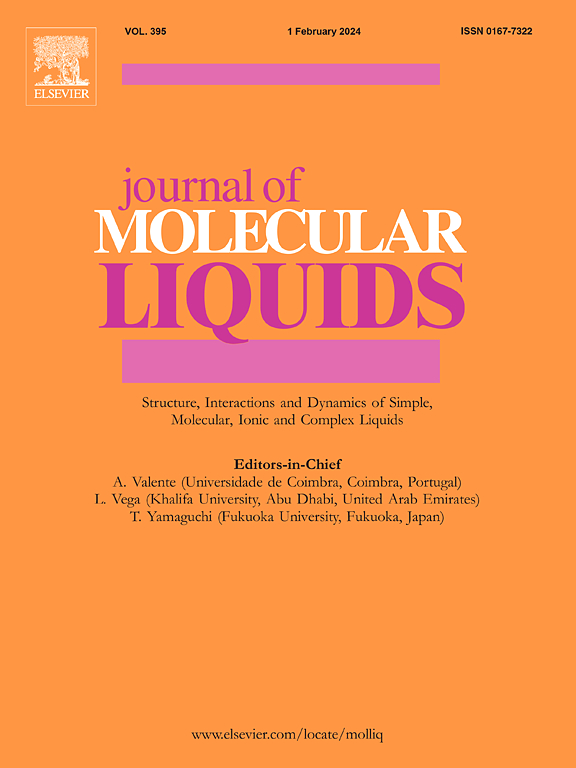阴离子聚合物和表面活性剂泡沫分离法去除铯
IF 5.3
2区 化学
Q2 CHEMISTRY, PHYSICAL
引用次数: 0
摘要
泡沫分离是一种利用表面活性剂在气液界面吸附的方法。由于泡沫表面的金属吸附位点(阴离子位点)数量有限,泡沫分离的缺点是去除率慢。为了提高离子聚合物对铯的去除率,研究了离子聚合物与阴离子表面活性剂的结合。泡沫分离采用两种表面活性剂:十二烷基磺基琥珀酸二钠(diSLSS)和十二烷基硫酸钠(SDS)。DiSLSS可以在水溶液中形成200纳米大小的囊泡。由丙烯酸制成的具有不同分子量的离子聚合物,用作吸附剂。在diSLSS表面活性剂体系中加入分子量为1800 g mol−1,初始浓度为0.08%的聚丙烯酸后,Cs的一级去除率(k)由7.0 × 10−4 min−1提高到2.0 × 10−3 min−1。此外,在diSLSS体系中,聚丙烯酸的分子量对Cs去除率没有显著影响。相反,聚丙烯酸的加入降低了SDS水溶液中Cs的去除率。光谱测量表明,在泡沫分离过程中,聚丙烯酸在diSLSS水溶液中的含量逐渐减少。然而,聚丙烯酸不能在气液界面有效吸附,泡沫分离后主要留在SDS溶液中。此外,在diSLSS水溶液中,聚丙烯酸的加入进一步降低了表面张力值(γ),而在SDS体系中,水溶液的γ略有增加。这些结果表明,聚丙烯酸的加入有利于在diSLSS系统的气泡界面上吸附。此外,聚丙烯酸的加入增加了水溶液中diSLSS囊泡的大小,降低了zeta电位。这意味着聚丙烯酸被吸附在囊泡表面或与膜结合并随泡沫一起去除。这些结果表明,在含有亲水粒子(如囊泡)的水溶液中,加入聚丙烯酸有利于Cs的去除。本文章由计算机程序翻译,如有差异,请以英文原文为准。

Cesium removal by foam separation involving anionic polymer and surfactant
Foam separation is a method that utilizes the adsorption of surfactants at the gas–liquid interface. Foam separation has the disadvantage of a slow removal rate owing to the limited number of metal adsorption sites (anionic sites) on the bubble surface. This study was conducted to increase the cesium removal rate using ionic polymers with anionic surfactants. Two types of surfactants were used for foam separation: disodium lauryl sulfosuccinate (diSLSS) and sodium dodecyl sulfate (SDS). DiSLSS can form vesicles 200 nm in size in an aqueous solution. An ionic polymer with varying molecular weight made from acrylic acid acted as an adsorbent.
The first-order of removal rate (k) of Cs increased from 7.0 × 10−4 min−1 to 2.0 × 10−3 min−1 by adding polyacrylic acid (molecular weight: 1800 g mol−1, initial concentration: 0.08 %) to the diSLSS surfactant system. In addition, the molecular weight of polyacrylic acid did not significantly affect the Cs removal rate in the diSLSS system. In contrast, the addition of polyacrylic acid decreased the Cs removal rate in the SDS aqueous solution.
Spectroscopic measurements revealed that the amount of polyacrylic acid gradually decreased in the aqueous solution of diSLSS during foam separation. However, polyacrylic acid does not effectively adsorb at the gas–liquid interface and remains primarily in the SDS solution after foam separation.
Additionally, in the diSLSS aqueous solution, the addition of polyacrylic acid further reduced the surface tension value (γ), whereas in the SDS system, the γ of aqueous solution exhibited a slight increase. These results indicate that the addition of polyacrylic acid is advantageous for adsorption onto the bubble interface in the diSLSS system. Furthermore, the addition of polyacrylic acid increased the size of the diSLSS vesicles in the aqueous solution and decreased the zeta potential. This implied that polyacrylic acid was adsorbed onto the vesicle surface or incorporated into the membrane and removed along with the foam. These results indicate that the addition of polyacrylic acid favors the removal of Cs in aqueous solutions containing hydrophilic particles such as vesicles.
求助全文
通过发布文献求助,成功后即可免费获取论文全文。
去求助
来源期刊

Journal of Molecular Liquids
化学-物理:原子、分子和化学物理
CiteScore
10.30
自引率
16.70%
发文量
2597
审稿时长
78 days
期刊介绍:
The journal includes papers in the following areas:
– Simple organic liquids and mixtures
– Ionic liquids
– Surfactant solutions (including micelles and vesicles) and liquid interfaces
– Colloidal solutions and nanoparticles
– Thermotropic and lyotropic liquid crystals
– Ferrofluids
– Water, aqueous solutions and other hydrogen-bonded liquids
– Lubricants, polymer solutions and melts
– Molten metals and salts
– Phase transitions and critical phenomena in liquids and confined fluids
– Self assembly in complex liquids.– Biomolecules in solution
The emphasis is on the molecular (or microscopic) understanding of particular liquids or liquid systems, especially concerning structure, dynamics and intermolecular forces. The experimental techniques used may include:
– Conventional spectroscopy (mid-IR and far-IR, Raman, NMR, etc.)
– Non-linear optics and time resolved spectroscopy (psec, fsec, asec, ISRS, etc.)
– Light scattering (Rayleigh, Brillouin, PCS, etc.)
– Dielectric relaxation
– X-ray and neutron scattering and diffraction.
Experimental studies, computer simulations (MD or MC) and analytical theory will be considered for publication; papers just reporting experimental results that do not contribute to the understanding of the fundamentals of molecular and ionic liquids will not be accepted. Only papers of a non-routine nature and advancing the field will be considered for publication.
 求助内容:
求助内容: 应助结果提醒方式:
应助结果提醒方式:


